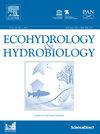Expanding the habitat quality assessment of rivers in Greece using an updated River Habitat Survey toolbox
IF 2.2
4区 环境科学与生态学
Q2 ECOLOGY
引用次数: 0
Abstract
Although most of the EU members have adopted methods for assessing the hydromorphological quality of lotic ecosystems in line with the Water Framework Directive, until now, Greece lacked an integrated approach. In this article, we present the results of the first nationwide assessment of habitat quality for rivers in Greece, using the River Habitat Survey (RHS) alongside a typology of Greek rivers. The RHS toolbox software has been updated with data from the Greek monitoring program which allowed for type-specific assessments using the Habitat Quality Assessment (HQA) score. The HQA scores from 366 monitoring sites were analyzed to identify spatial patterns and significant variations. Sites were classified in five HQA classes based on the position of their HQA score relative to sites of similar types. We also investigated whether Ecological Quality Ratios (EQRs) for three biological quality elements (benthic diatoms, benthic macroinvertebrates and fish) differed significantly among HQA classes. Correlations showed that sites at mid and high altitude catchments with natural land cover had better HQA scores than lowland sites with agricultural land cover. In addition, large urbanized districts (e.g. Attica), and central Greece displayed lower habitat quality than Epirus and Western Macedonia. Our findings revealed that EQR values varied significantly among the HQA classes, with these differences being more prominent for small and medium lowland streams. This study shows that this approach can identify sites that are prone to habitat degradation and require further management, whilst providing a consistent framework for exploring the relationships between biota and hydromorphological conditions.
利用更新的河流生境调查工具箱扩大希腊河流生境质量评估范围
尽管大多数欧盟成员国都采用了与《水框架指令》一致的水文生态系统水文形态质量评估方法,但到目前为止,希腊还缺乏一种综合方法。在这篇文章中,我们介绍了希腊河流栖息地质量的第一次全国评估结果,使用河流栖息地调查(RHS)和希腊河流的类型学。RHS工具箱软件已经更新了来自希腊监测项目的数据,该项目允许使用栖息地质量评估(HQA)评分进行特定类型的评估。分析了366个监测点的HQA得分,以确定空间格局和显著差异。根据网站的HQA分数相对于类似类型网站的位置,将网站分为五个HQA类。我们还研究了三种生物质量元素(底栖硅藻、底栖大型无脊椎动物和鱼类)的生态质量比(EQRs)在HQA类别之间是否存在显著差异。相关性表明,具有自然土地覆盖的中、高海拔流域的HQA得分高于具有农业土地覆盖的低海拔流域。此外,大型城市化地区(如阿提卡)和希腊中部的栖息地质量低于伊庇鲁斯和马其顿西部。研究结果表明,EQR值在不同的HQA类别中存在显著差异,这些差异在中小低地河流中更为突出。该研究表明,该方法可以识别出易发生生境退化并需要进一步管理的地点,同时为探索生物群与水文形态条件之间的关系提供了一致的框架。
本文章由计算机程序翻译,如有差异,请以英文原文为准。
求助全文
约1分钟内获得全文
求助全文
来源期刊

Ecohydrology & Hydrobiology
Agricultural and Biological Sciences-Aquatic Science
CiteScore
5.40
自引率
3.80%
发文量
51
期刊介绍:
Ecohydrology & Hydrobiology is an international journal that aims to advance ecohydrology as the study of the interplay between ecological and hydrological processes from molecular to river basin scales, and to promote its implementation as an integrative management tool to harmonize societal needs with biosphere potential.
 求助内容:
求助内容: 应助结果提醒方式:
应助结果提醒方式:


